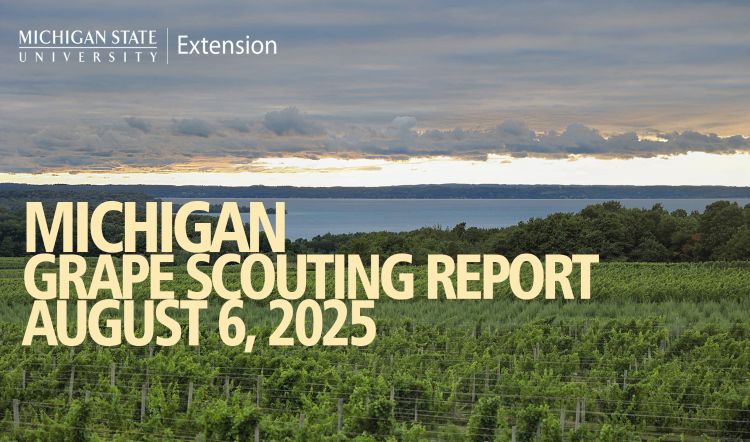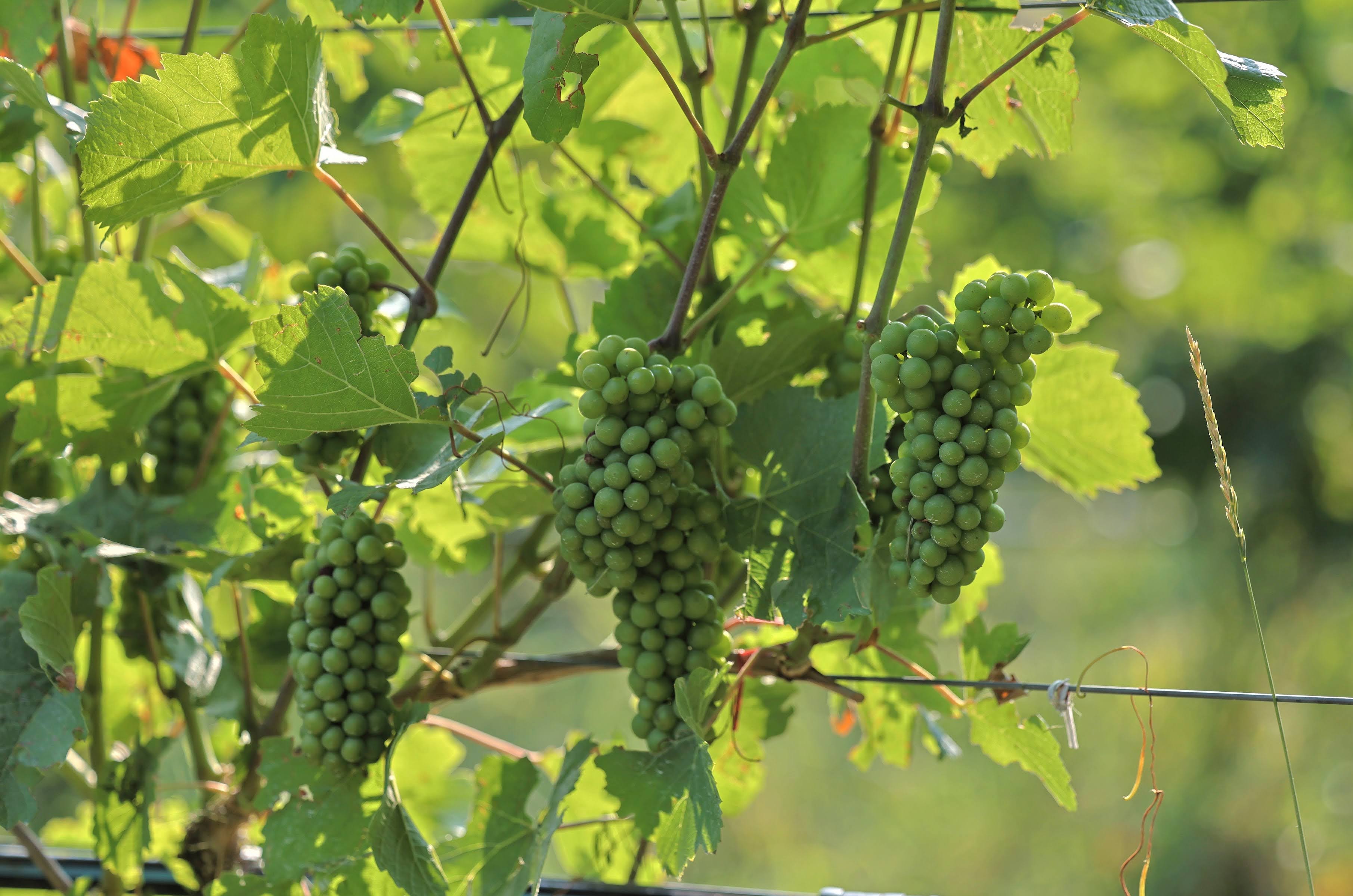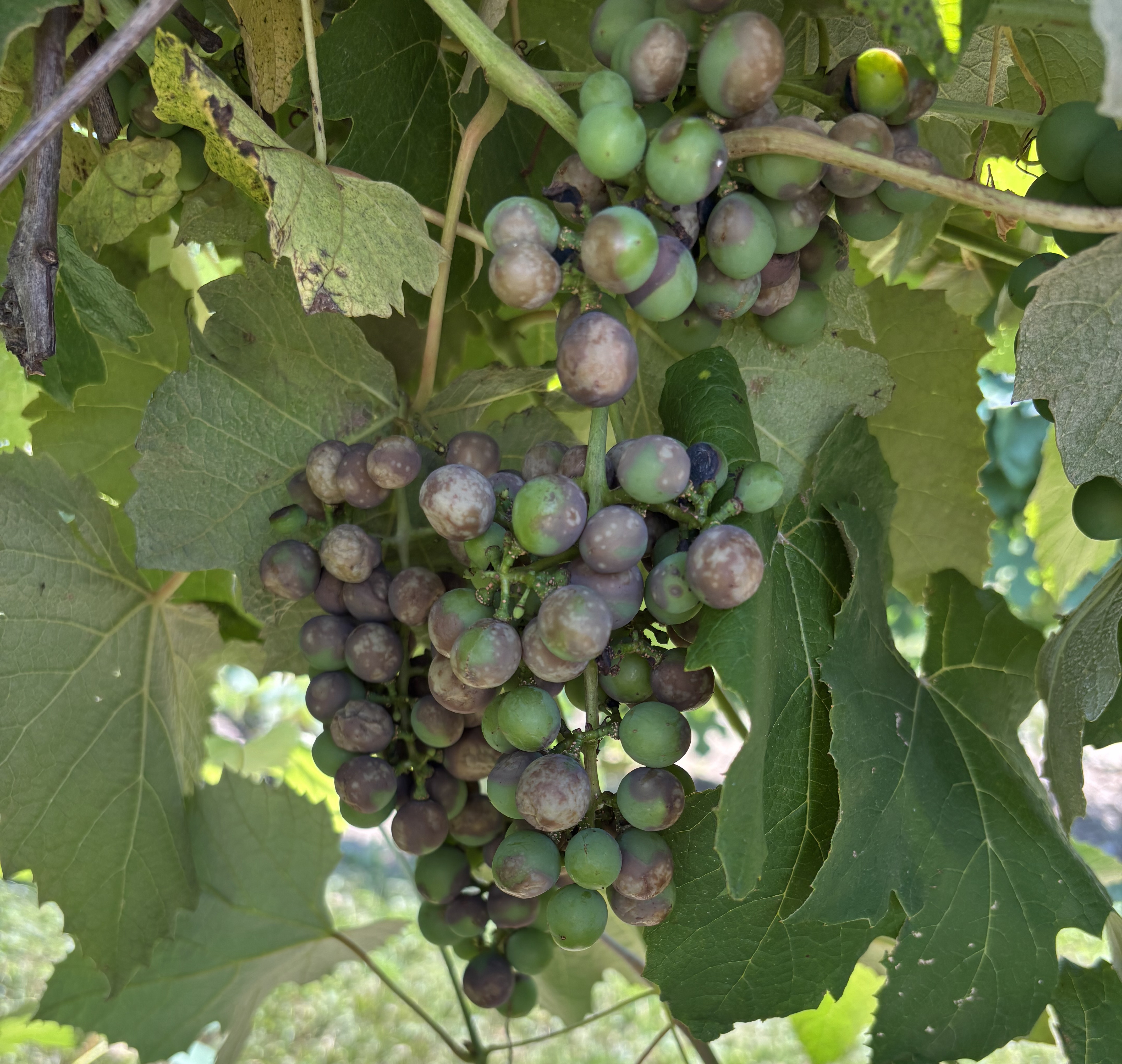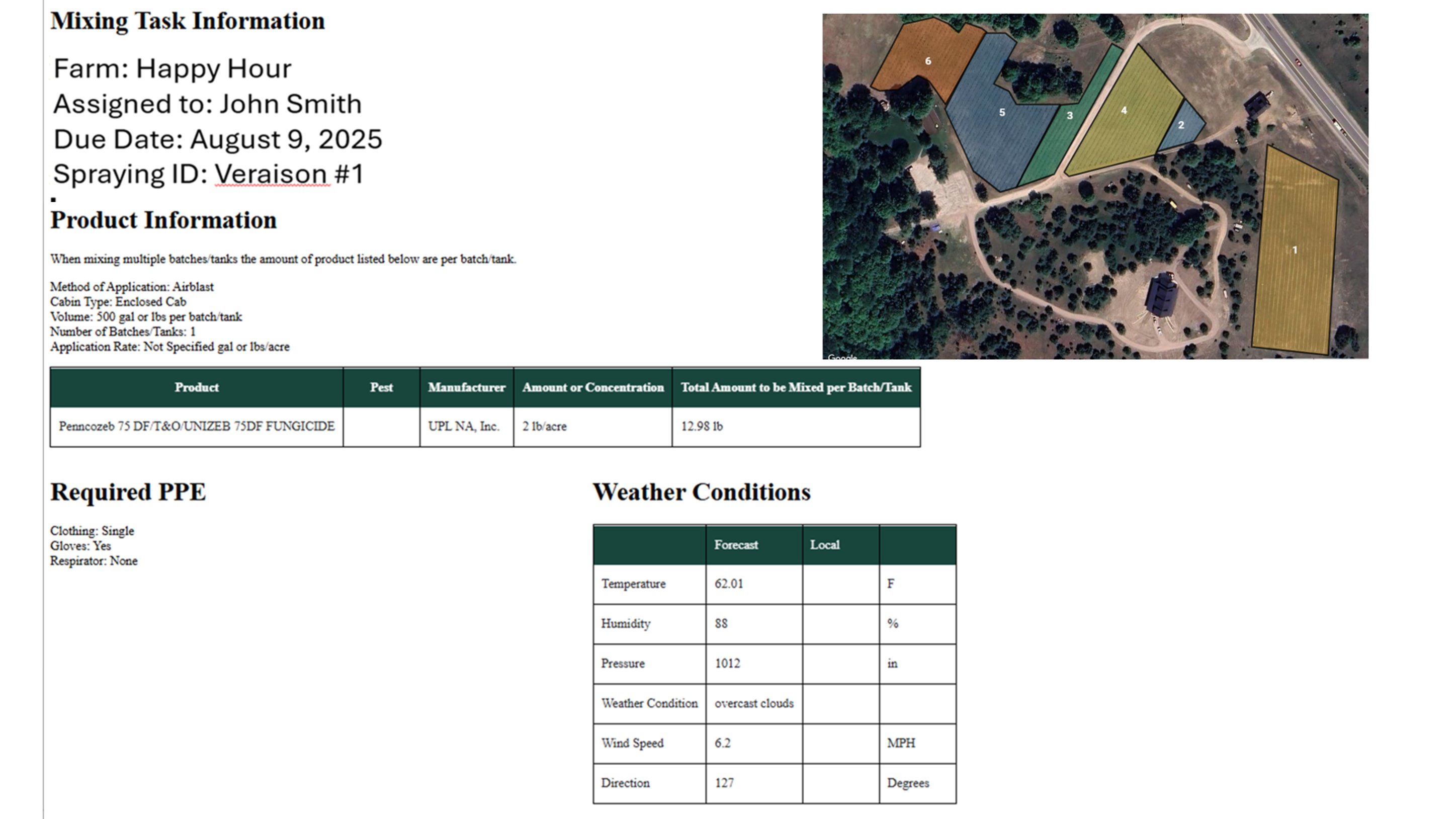Michigan grape scouting report – August 6, 2025
Check out the latest Michigan Grape Scouting Report for timely updates on weather, vine growth, disease management, and pest activity. Stay informed and make proactive decisions to support vineyard health and productivity.

Weather update
Detailed seven-day forecasts for Michigan grape production regions are available below:
- Southwest Michigan: Benton Harbor, Fennville, Lawton
- Southeast Michigan: Romeo
- Northwest Michigan: Old Mission, Petoskey, Traverse City
Agricultural Weather Outlook: Weekly in-season weather updates are provided to the Michigan State University Extension fruit team by Jeff Andresen, Michigan State University (MSU) agricultural meteorologist. These reports offer timely insights into weather conditions affecting fruit production across Michigan.
Growing degree day (GDD) report
Track vine development using the MSU Enviroweather Growing Degree Day (GDD) map. Visit the site to find your nearest weather station, create a free account, and monitor GDDs daily: MSU Enviroweather GDD Tool
Weekly GDD summary (Base 50 F)
The table below summarizes current GDD accumulation, last week's totals, and the weekly increase for each monitored location across Michigan:
|
Location |
Current GDD (Base 50 F) |
GDD Last Week |
Weekly Accumulation |
|---|---|---|---|
|
Benton Harbor (SWMREC) |
2017.9 |
1878.3 |
139.6 |
|
Fennville |
1855.0 |
1719.6 |
135.4 |
|
Lawton |
1982.2 |
1852.1 |
130.1 |
|
Average – Southwest Michigan |
1951.7 |
1816.7 |
135.0 |
|
Romeo |
1810.4 |
1679.1 |
131.3 |
|
Average – Southeast Michigan |
1810.4 |
1679.1 |
131.3 |
|
Old Mission |
1399.2 |
1282.5 |
116.7 |
|
Petoskey |
1335.8 |
1229.7 |
106.1 |
|
Traverse City (NWMHRS) |
1517.6 |
1388.4 |
129.2 |
|
Average – Northwest Michigan |
1417.5 |
1300.2 |
117.3 |
Weather forecast
Southern Michigan saw a cooldown last week with several days staying below 80 degrees Fahrenheit. Humidity was also lower, bringing low temperatures into the 50s for the first time in several weeks. A cold front passed through the area on the afternoon of Wednesday, July 30, bringing cooler temperatures along with some well-deserved rain. Most areas saw around half an inch of rain. The north winds also brought some significant haze as a result of the Canadian wildfires, causing some caution days for workers outside.
Northern Michigan saw a similar trend in temperatures and conditions. Daily high temperatures dropped into the low 70s before rebounding at the beginning of this week. Lows reached into the upper 40s a couple nights. Unfortunately, northern Michigan did not experience any of the rains seen further south.
The forecast is for a gradual warming through the weekend with some unstable air moving through at the beginning of next week. This will potentially result in some minor chances of light rain amounts and slightly lower temperatures towards the beginning of next week. Total rain amounts expected in the next seven days are less than a quarter inch for all grape growing regions.
Vine growth
In southwest Michigan, most hybrids are in the middle of or finishing veraison. Some vinifera are starting to show color as well, mainly burgundian cultivars. The second round of leaf pulling will begin soon. Final fruit thinning continues. Growers are starting to focus sprays on cluster protection products. Some growers are indicating harvest to begin in two weeks. The National Grape Cooperative has put out their harvest estimates indicating Concord harvest should begin around Sept. 28. No split harvest of Niagara is expected with harvest beginning on Oct. 13 after Concords are complete.
In northern Michigan, grape clusters are currently progressing through modified E–L phenology stages 31–33. Berry size ranges from approximately 7 millimeters (peppercorn size) to 9 millimeters (pea size), indicating steady fruit development.
- Stage 32: Beginning of bunch closure; berries are starting to touch (in tighter clusters).
- Stage 33: Berries remain hard and green.
For a precise visual reference, consult MSU Extension’s Grape Growth Stages chart.

In the Tip of the Mitt American Viticulture Area, hybrid cultivars continue with bunch closure and berry softening. Vitis vinifera cultivars are in the berry touch stage. Japanese beetle activity is persistent. Black rot, downy mildew and powdery mildew have been noted in some vineyards. Risk for each remains moderate.
In southeast Michigan, veraison has been moving through the region, with varieties like Marquette already showing fully colored clusters. The risk of powdery mildew infection is high throughout the week of Aug. 4-12. Black rot and downy mildew risk remain low this week.
Horticulture
Accurate assessment of vineyard nutrient requirements is essential for optimizing vine health, fruit quality and yield. Implementing soil testing and petiole analysis provides critical data to inform nutrient management strategies. A quality soil test or a previous year’s petiole analysis is important in understanding which nutrients the vineyard needs.
Petiole analysis should be done at bloom and veraison, and at specific stages of vine development when nutrient concentrations in the petiole are most stable and representative of the vine's overall status. The most widely recommended timing for petiole sampling is at full bloom, which occurs when approximately 70% of the flowers on a cluster are open. This stage provides the most reliable data for key nutrients such as nitrogen, phosphorus, potassium and micronutrients.
An alternative or complementary sampling period is at veraison, when about half of the berries on a cluster begin to change color or soften. Sampling at veraison can be useful for monitoring nutrients like potassium, magnesium and boron later in the season or for tracking changes in nutrient dynamics over time.
Cluster zone leaf removal: Timing and technique
To regulate grape quality in cool-climate regions, growers employ various canopy management practices to counter the challenges of a short growing season. One of the most impactful techniques is cluster zone leaf removal, which plays a key role in reducing disease pressure and enhancing fruit quality.
This practice improves spray coverage and airflow around the fruit, lowering humidity and minimizing the risk of harvest season cluster rot complex, including Botrytis and sour rot. Increased sunlight exposure also encourages development of a thicker wax cuticle on the berry skin, providing natural resistance to fungal infections and enhancing grape quality.
Leaf removal can be performed manually or mechanically, and the industry is rapidly transitioning toward mechanization to improve both efficiency and economic sustainability. The effectiveness of this practice depends heavily on timing, particularly in relation to grapevine phenology.
Leaf removal is typically applied between fruit set and veraison to improve cluster zone microclimate and increase disease resistance. When implemented around bloom or shortly before, it can also reduce fruit set and result in looser clusters, a valuable outcome for tight-clustered cultivars like Pinot noir and Riesling, which are prone to rot due to berry compression.
Early leaf removal, at pre-bloom or pea-size stage, offers additional benefits under climate change conditions:
- Promotes flavonol synthesis, protecting berries from UV damage.
- Reduces incidence of cluster rot, potentially lowering fungicide use.
Mechanical early leaf removal systems (Collard leaf remover) use compressed air to remove leaves and dead flower tissue from the fruit zone. Removing dead ovaries is critical, as they serve as an entry point and nutrient base for Botrytis spores. The pathogen can remain latent until berry sugar levels rise and acidity drops, after which rot symptoms develop rapidly in warm, humid conditions.
Read more in the MSU Extension article, “Cutting to the core: Michigan State research leads a canopy innovation in cool-climate viticulture.”
Diseases
In southwest Michigan, disease management of downy mildew, powdery mildew and botrytis fruit rot are the primary focus. The morning dews we will begin to experience are an important reminder to maintain protection against downy mildew. With tight clustered varieties, this is the last chance to get botrytis bunch rot sprays into the tight crevices of the clusters.
In northwest Michigan, disease pressure is still low but continues to increase in specific areas where black rot is becoming more apparent. Black rot symptoms are beginning to show up throughout the state (Photo 6), but it is largely too late to control these infections and fruits will begin to become resistant.
In this growing stage, consider choosing fungicides that control all the foliar and fruit diseases. For example, with downy mildew we are most concerned with foliar infection, and sprays should be timed regularly throughout the season when we experience heavy dews for optimal control. Downy mildew is caused by a fungal-like organism, so many site-specific systemic fungicides that target other spring diseases do not work on downy mildew. Effective fungicides for downy mildew include products in FRAC codes 4, 11, 21, 40 and 45 as well as phosphorus acid salts and some biologically-based products.

If powdery mildew is the only concern, there are a number of effective products (FRAC codes 3, 7, 11, 13, U8, 50, and U13 as well as sulfur). Combining fungicides from different FRAC classes should also be effective while helping with resistance management.
As we approach bunch closure in southwest Michigan, consider botrytis management. Several strategies contribute to good botrytis bunch rot management including opening up the canopy, properly applying fungicides, and using resistant cultivars when possible. Good botrytis control depends on getting good coverage. Just before bunch closure is the last chance to apply a fungicide to the inner part of the developing cluster. Fungicide resistance management is also important. The most effective products for botrytis are site specific and prone to resistance development. A Michigan Grape Fact Sheet is available for managing botrytis bunch rot.
As you choose a fungicide, check the guide for potential phytotoxicity of certain sprays on Concord grapes especially (this has been particularly noted for fungicides like Revus Top). Phytotoxicity risk is higher with high temperatures and quickly growing vines. Also, there is a significant phytotoxicity risk with specific contact products such as copper and sulfur for Labrusca type grapes (Concord and Niagara).
Insects
The third generation of grape berry moth is underway in southwest Michigan vineyards, requiring protection if weekly scouting indicates high levels of infestation. This tends to be along wooded borders, but checking through vineyards at this time of the year is a good idea to know how the crop looks in preparation for the upcoming harvest, as well as to see if full cover or border applications are warranted. There are various registered insecticides available with high activity on this pest, but they vary widely in their pre-harvest intervals.
With veraison observed in some regions already and harvesting approaching for early varieties, it will be important to check preharvest interval (PHI) values. Later harvested Niagara blocks still have over a month until harvest. In those vineyards, Intrepid or Intrepid Edge could still be used with the 30-day PHI. If using either Intrepid or Intrepid Edge, excellent cluster coverage is required with a spreader-sticker adjuvant.
Other options for berry moth control include Altacor, Verdpryn and Imidan, which can provide about 14 days protection, or various pyrethroids that can provide about seven days control. There are also many biological options registered including Dipel and Javelin B.t.s, or Grandevo, which can all be used in organic vineyards. Check the Michigan Fruit Management Guide, bulletin E-154, for the full list of options.
As vineyards approach veraison, be alert for the risk of sour rot. This disease is caused by the combination of bacteria, fungi and vinegar flies. It is worst in sites with susceptible cultivars and during warm late summer conditions. With some recent intense rainfall in some areas, there may be berry cracking which can act as a starting point for infections.
SAM Tool helps you meet Worker Protection Standard requirements
Did you know? One of the many practical features of the Sustainable Agriculture Management (SAM) Tool is its ability to generate a printable PDF of each pesticide application task.
This printout can be posted at a central display location to meet the U.S. Environmental Protection Agency’s Worker Protection Standard (WPS) requirements—keeping your workers informed about recent sprays, restricted entry intervals and treated areas. It can also be handed out as task instructions, especially useful for workers who prefer not to read task instructions in the SAM Tool mobile app on their phones.

Simple, compliant and worker-friendly—that's the SAM Tool advantage. If you have questions, want help getting started or have suggestions for improvement, please contact us at https://sustainableag.msu.edu/ or reach out to Karen Chou directly at chouk@msu.edu. Let’s keep building the SAM Tool together!
Party on the Piazza: Volunteers needed plus Georgian wine tasting

Join us for an evening of community, connection and celebration at Party on the Piazza on Thursday, Aug. 21, from 5-9:30 p.m. at the Grand Traverse Commons.
This relaxed, festive gathering brings together friends and colleagues from across Michigan’s wine and grape industry. One of the evening’s highlights will be a Georgian wine tasting led by Nino Sachaleli, PhD, a visiting expert from the Republic of Georgia. She’ll be sharing wines and stories from one of the world’s oldest winemaking traditions.
We’re also looking for volunteers to help make this event a success, whether it's setting up, pouring wine or helping with coordination. If you're interested in being part of the team, fill out the volunteer registration form by August 15, 2025.
You're also invited to bring a bottle of your own wine to share. Let’s make this a memorable celebration of wine, culture and connection. Raise a glass and celebrate the season together!
Upcoming events
2025 Dirt to Glass Conference: Elevating Michigan Wine from the Ground Up
Join grape growers, winemakers, researchers and industry leaders Aug. 21-22 in Traverse City, Michigan, for two days of insight, collaboration and innovation. From site selection to sustainable practices and wine marketing, this event is designed to strengthen Michigan’s wine industry—one vine and one voice at a time. Register now and be part of the movement from intention to impact.
2025 Great Lakes EXPO – Grape Session
Join us at the 2025 Great Lakes Fruit, Vegetable & Farm Market EXPO, happening Dec. 9–11 in Grand Rapids, Michigan!
This year’s grape session will bring together growers, researchers and industry experts to explore the latest in vineyard management, disease control, varietal updates and innovative technologies tailored for the Great Lakes region.
Whether you're new to grape growing or a seasoned professional, this session offers practical insights, valuable connections, and tools to help you grow smarter.
Don't miss it—visit the Great Lakes EXPO website to register and join us in December!
Follow us on Facebook and Instagram for the latest industry news, educational programs and viticulture resources. Stay connected and informed with timely updates and expert insights.
Related articles
- Early hedging for healthier canopies and better ripening in cool climates
- Rose chafer management for northwest vineyards
- Fruit insecticide registration update for 2023
- Southwest Michigan fruit update – June 4, 2024
- Michigan grape scouting report – June 15, 2022
- MSU Fruit Pest Management Guide (E-154)
- Grape growth stages
- Early season vineyard disease management
- Early season vineyard management
- A Mobile Guide for Grape IPM Scouting in North Central and Eastern U.S.
- Using the MSU Enviroweather grape berry moth model in 2018



 Print
Print Email
Email
